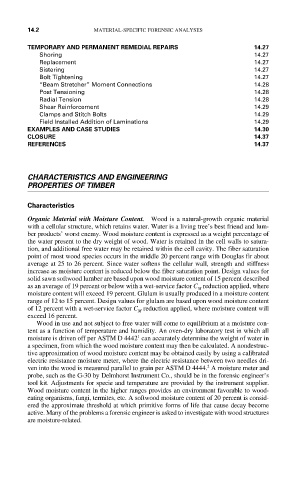Page 511 - Forensic Structural Engineering Handbook
P. 511
14.2 MATERIAL-SPECIFIC FORENSIC ANALYSES
TEMPORARY AND PERMANENT REMEDIAL REPAIRS 14.27
Shoring 14.27
Replacement 14.27
Sistering 14.27
Bolt Tightening 14.27
“Beam Stretcher” Moment Connections 14.28
Post Tensioning 14.28
Radial Tension 14.28
Shear Reinforcement 14.29
Clamps and Stitch Bolts 14.29
Field Installed Addition of Laminations 14.29
EXAMPLES AND CASE STUDIES 14.30
CLOSURE 14.37
REFERENCES 14.37
CHARACTERISTICS AND ENGINEERING
PROPERTIES OF TIMBER
Characteristics
Organic Material with Moisture Content. Wood is a natural-growth organic material
with a cellular structure, which retains water. Water is a living tree’s best friend and lum-
ber products’ worst enemy. Wood moisture content is expressed as a weight percentage of
the water present to the dry weight of wood. Water is retained in the cell walls to satura-
tion, and additional free water may be retained within the cell cavity. The fiber saturation
point of most wood species occurs in the middle 20 percent range with Douglas fir about
average at 25 to 26 percent. Since water softens the cellular wall, strength and stiffness
increase as moisture content is reduced below the fiber saturation point. Design values for
solid sawn softwood lumber are based upon wood moisture content of 15 percent described
as an average of 19 percent or below with a wet-service factor C reduction applied, where
M
moisture content will exceed 19 percent. Glulam is usually produced in a moisture content
range of 12 to 15 percent. Design values for glulam are based upon wood moisture content
of 12 percent with a wet-service factor C reduction applied, where moisture content will
M
exceed 16 percent.
Wood in use and not subject to free water will come to equilibrium at a moisture con-
tent as a function of temperature and humidity. An oven-dry laboratory test in which all
1
moisture is driven off per ASTM D 4442 can accurately determine the weight of water in
a specimen, from which the wood moisture content may then be calculated. A nondestruc-
tive approximation of wood moisture content may be obtained easily by using a calibrated
electric resistance moisture meter, where the electric resistance between two needles dri-
2
ven into the wood is measured parallel to grain per ASTM D 4444. A moisture meter and
probe, such as the G-30 by Delmhorst Instrument Co., should be in the forensic engineer’s
tool kit. Adjustments for specie and temperature are provided by the instrument supplier.
Wood moisture content in the higher ranges provides an environment favorable to wood-
eating organisms, fungi, termites, etc. A softwood moisture content of 20 percent is consid-
ered the approximate threshold at which primitive forms of life that cause decay become
active. Many of the problems a forensic engineer is asked to investigate with wood structures
are moisture-related.

